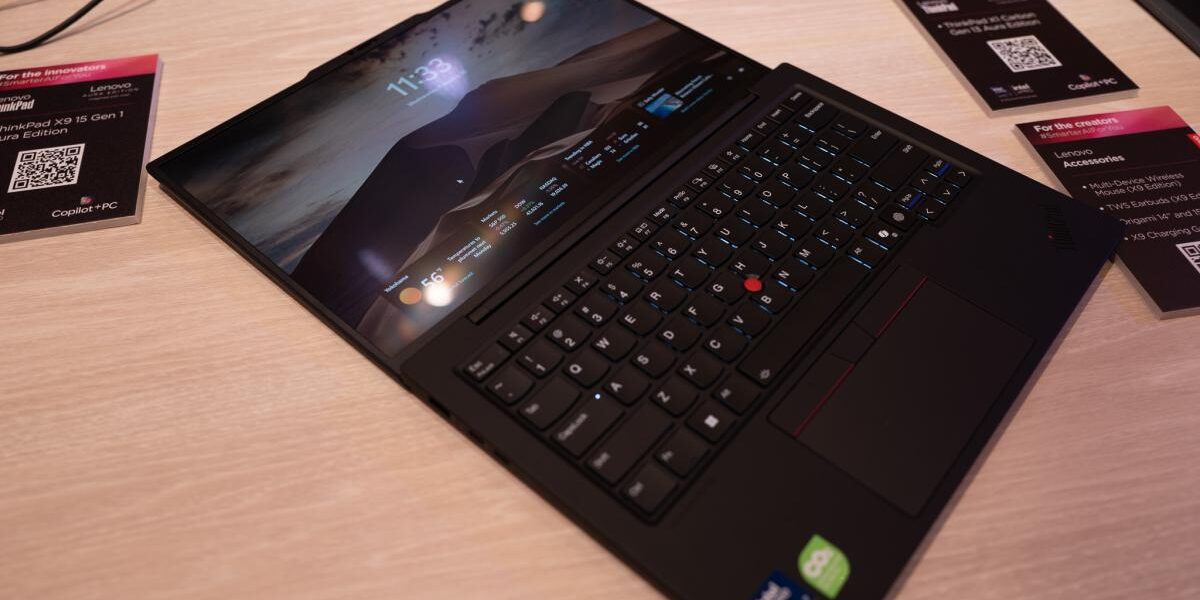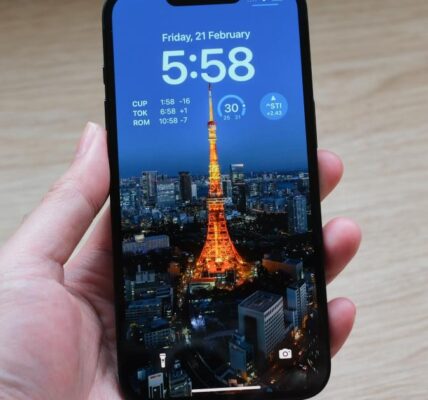From user research to hinge design: Inside Lenovo’s rethink of the laptop experience
Note: This feature was first published on 3 April 2025.

HardwareZone was recently invited to the Lenovo Aura Edition AI PC media event that was held in Yokohama, Japan, and we were given a closer look at the engineering and thinking behind Lenovo’s new Aura Edition AI PCs. Developed in partnership with Intel, the Aura Edition ThinkPad laptops is Lenovo’s latest attempt to rethink the premium PC experience –not by adding more features, but by making the right ones more accessible and intuitive.
To better understand the collaboration, the design process, and the long-term implications of the Aura Edition platform, we spoke with Kevin Beck, Senior Story Technologist at Lenovo’s Intelligent Devices Group. In this Q&A, he explains how years of research informed the development strategy, what Lenovo learned about user expectations, and how even seemingly minor design changes – like a hinge – can reshape the experience of using a laptop.
HWZ: Kevin, I’d like to start by asking about Lenovo’s collaboration with Intel, specifically on the Aura Edition. Could you walk us through how this partnership unfolded, and whether there were any unexpected insights or breakthroughs that helped shape the final Aura Editions we see today?
Kevin: Sure. I wasn’t directly involved in the earliest stages, so I’ll share what I know from a bit of internal history. It started as a research project – a 10,000-person survey aimed at understanding what people truly value from an experiential standpoint. We already had a sense of the features and functions users ask for, but we wanted to dig deeper: what do they actually value, and how do they think about those things holistically?
Interestingly, the research helped answer a question someone else asked earlier today (Ed’s note: During Kevin’s presentation) – why many of the features in (the) Aura Edition already existed in other forms. That was intentional. Think of it this way: if a tree falls in the forest and no one hears it, does it make a sound? If we, together with Intel, invest time, money, and effort into new features, but users never discover or use them – was it really worth it?
So part of the project was about understanding how we could improve the discoverability and perceived value of what we already had. We know, for example, that roughly 24-25% of all PCs globally fall into a particular user segment – that figure’s even slightly higher on the commercial side. But that still means about 75% of people aren’t buying those kinds of PCs. We needed to understand how people think and feel about their devices to find new opportunities.
That led us into two major workstreams. Once we had the experience-first strategy sorted, we split efforts: one group worked on the more software-driven, experiential side – things like Smart Modes and Smart Share – while another focused on Smart Care, which is more about ownership and user journey. On the spec side, it all funnelled into the development of the ThinkPad X9 platform.
From there, the collaboration with Intel expanded. Our design team worked closely with them, from the platform-level fundamentals – power and cooling, for example – to details like camera and audio subsystem development, screen interface, and even board layout. A lot of this was about creating space, literally, to deliver better airflow and acoustics. For instance, we had to re-engineer the hinge design entirely. The original 5.5mm diameter hinges had to be reduced to 3.5mm to create enough of a gap for optimal airflow. That was essential for both thermal and acoustic performance.
To answer your question directly, all of that research was distilled into a detailed set of experiential requirements for (ThinkPad) X9 and Aura. Our user experience team created those requirements, and the engineers were given targets – not how to do it, but what to aim for. It was a systematic, research-backed process that still left room for engineering creativity.
@hwztech We saw some old ThinkPad friends at the Yamato Lab in Yokohama, Japan. Have you seen or owned any of these? @Lenovo #lenovo #thinkpad #ibm #laptop #technology #pc #computer #yamatolab #smarteraiforyou ♬ Memory Lane – Orchestral Version – Haley Joelle
HWZ: After visiting the Yamato Lab, I was reminded of ThinkPad’s history of bold, experimental designs. In recent years, we’ve seen fewer of these. Has market demand, cost, or a change in philosophy contributed to that shift?
Kevin: I’d say you’re right – there were moments in ThinkPad’s history where we introduced really experimental concepts, like the butterfly keyboard. At one point, we had modern-style detachables, Helix models that depended on the base for cooling and battery life, tablets with twisting displays. Lots of experimentation.
Nowadays, the Lenovo Yoga-style 360-degree hinge has clearly won in the market. But I wouldn’t say innovation has stopped. The ThinkPad X1 Fold, for instance, is a recent and bold example. It’s not that we’ve abandoned those ideas but that we now have more product lines and can choose where to explore new ideas. For example, the ThinkBook Plus was another experimental form factor.
At IFA, we showed a prototype with a central hinge that could follow the user – kind of a revival of the “beak” design. That was proof-of-concept, but the rollable display also started as a concept and is now headed for production. We’re still very much in the game.
And fun fact: the gentleman who led ThinkPad development still consults with us. He once said there will never be a zero-millimetre-thick ThinkPad, which I think nicely summarises the limits of innovation. We’re still guided by practicality.
HWZ: Looking ahead, do you see the innovations in Aura Edition influencing future Lenovo products? Will there be any hardware or software breakthroughs that are likely to carry forward to Snapdragon or AMD laptops?
Kevin: Absolutely. On the software side, it’s not just the content but also how the functions are grouped and accessed. That was a big learning from Aura – putting related settings together in ways users naturally associate them.
Hardware-wise, the hinge design from ThinkPad X9 is a good example. Getting a hinge that opens with one finger, stays in place, and doesn’t lift the base is surprisingly difficult. We used a hybrid tension mechanism – springs and clutches – to get that right. Reducing the hinge size gave us more space for better airflow. That will likely influence future models, even if I can’t say for sure which ones.

As for features carried over from previous generations, well yes, we kept many but refined their accessibility. For example, wellness features already existed, but you had to dig into settings to find them. Now they’re surfaced in a more coherent and accessible way. Research showed us how users perceive and discover features, and that’s shaping how we surface functionality going forward.
Even things like human presence detection like on the ThinkPad X1, that’s handled by a dedicated computer vision chip. On the X9, we’ve moved to a more efficient time-of-flight sensor. It can’t do everything the vision chip can, but it’s much more energy-efficient. We had to train it to detect faces at the edges of its narrower field of view, but now it works just as well in practice.
We’ve also improved beamforming audio and introduced voice ID—enrolling your voice locally to filter out others during calls using a convolutional neural net. These kinds of improvements show how we’re using AI computational power to enhance core experiences meaningfully.
HWZ: Final question and it’s in two parts. First, the laptop form factor hasn’t changed drastically since its inception, just like smartphones. What’s your personal vision of the laptop’s future? And second, will form factor evolution be driven more by hardware or software?
Kevin: To answer the second part first: both, but in different ways. Hardware sets the limits to what’s possible. Software defines the usefulness and what’s worth doing. I don’t think ultra-thinness should be the only goal. At some point, things get too light and too fragile.
Foldables are an interesting direction and we’ve been exploring them for a while. But the key is use case. With the X1 Fold, for instance, we didn’t want it to just be a device that folds. We wanted it to offer real benefits: split-screen productivity, flexible orientation, speaker alignment based on rotation, that sort of thing.
You’re right to draw parallels with smartphones – from clamshells to candy bars to foldables. The difference is that the PC market tends to converge more decisively. Over time, one form factor usually wins. With tablets, for instance, the all-in-one with kickstand and detachable keyboard has clearly emerged as the dominant form.
We’re still exploring, but long-term, I expect the market to settle on form factors that deliver real, tangible user value—not just novelty.




